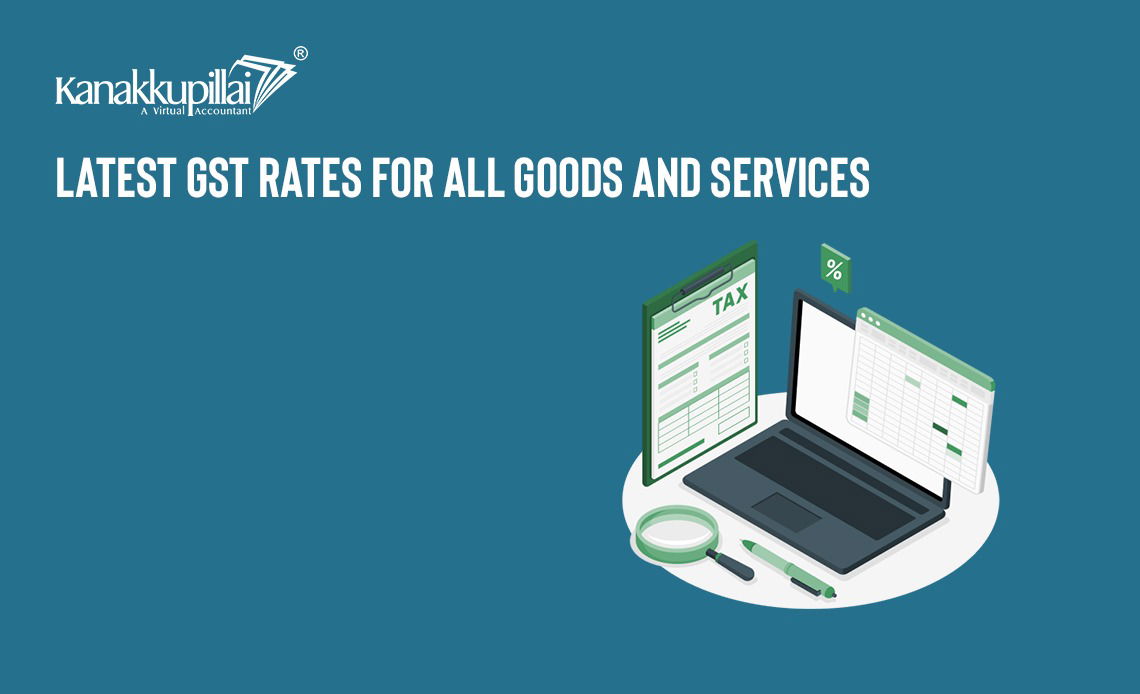The Goods and Services Tax (GST) in India is a transformative tax regime that replaced a complicated web of indirect taxes. Predicted to simplify the tax structure and foster monetary growth, GST has emerged as the cornerstone of the nation’s fiscal panorama.
Significance of Staying Updated on Latest GST Rates
Staying abreast of the trendy GST rates for goods and offerings is not merely a financial workout but a strategic imperative. The dynamic nature of GST quotes displays the evolving economic panorama and governmental policies. Ordinary updates are critical for businesses and purchasers alike to make informed financial selections, ensure compliance, and navigate the nuances of taxation in unexpectedly changing surroundings.
Knowing the GST rates, classified as Nil, 5%, 12%, 18%, and 28%, is pivotal. Every category has implications for agencies, from critical commodities to luxury items and an array of services, influencing pricing strategies, earnings margins, and patron picks.
This blog delves into the intricacies of the contemporary GST costs, shedding light on items and offerings throughout distinct slabs, and elucidates the factors that make contributions to the ever-evolving tax panorama. In doing so, it empowers organizations and individuals to navigate the complexities of GST, make knowledgeable economic selections, and contribute to the broader economic narrative.
GST Rate Structure
The GST rate shape in India is multifaceted, encompassing various categories designed to streamline taxation. Those categories encompass Nil, 5%, 12%, 18%, and 28%, each associated with precise kinds of goods and services. The breakdown of GST rates is as follows:
- Nil rate: services and products falling below this category incur no GST. It frequently consists of vital objects to relieve the tax burden on necessary commodities.
- 5% rate: A slight charge for items and services considered necessities, no longer falling underneath the Nil class.
- 12% rate: applied to items falling in a mid-range category, balancing tax sales and client affordability.
- 18% rate: goods and offerings attracting this charge represent a higher tax bracket, overlaying a wide spectrum of merchandise.
- 28% rate: the best GST fee, reserved for luxurious gadgets and pick-out services.
Knowing the criteria influencing rate categorization is essential. Factors, along with the nature of the products or services, their perceived necessity, and their contribution to the economic system, play a role in determining an appropriate GST price.
Dynamic Nature of GST Charges
The GST rate structure is dynamic, and making periodic revisions primarily based on financial issues, industry demands, and governmental rules is difficult. This dynamism permits flexibility in responding to the evolving needs of the economy. Elements influencing adjustments in GST rates consist of the following:
- Monetary situations: adjustments in GST costs respond to the winning financial conditions, aiming to strike a balance between sales era and consumer affordability.
- Industry-specific concerns: sure sectors may witness tailored GST charges to assist in increasing, incentivizing investments, or dealing with unique challenges.
Significance of Periodic Updates for Companies and Consumers:
Normal updates on GST costs are imperative for corporations and clients alike. Companies must align pricing strategies, update accounting systems, and ensure compliance with today’s tax structures. For purchasers, staying knowledgeable aids in making informed shopping choices, information on the tax implications of various products and services, and adapting to adjustments of their expenditure styles. In essence, periodic updates on GST rates foster transparency, compliance, and knowledgeable selection-making in India’s complicated tax panorama.
Ultra-modern GST Rates for Goods
1. Nil and Exempted items:
Expertise in the nuances of products falling under the Nil and Exempted categories is important for companies and purchasers. The Nil class includes goods on which no GST is levied, ensuring affordability for essential objects. Exempted items, whilst not attracting GST, can also have sure conditions. An in-depth listing and explanations offer clarity on the scope of those categories. The impact on agencies coping with those goods is massive, influencing pricing strategies, income margins, and marketplace competitiveness.
2. Goods at 5% and 12%:
Items attracting GST at 5 and 12% rates shape a tremendous portion of the patron panorama. A comprehensive assessment sheds light on the numerous range of products falling under those classes. Examples of daily necessities and positive services illustrate the breadth of goods and those fees. This section offers businesses and purchasers insights into the tax implications on typically used items, facilitating informed selection-making.
3. Goods at 18% and 28%:
Delving into better GST rates of 18% and 28%, this segment affords an in-depth exploration of products subjected to these fees. Luxury gadgets, premium items, and chosen services fall under these classes. Analysis of the economic implications explores how better tax charges affect patron behaviour, marketplace calls for, and industry dynamics. Corporations dealing with goods in those classes should navigate the challenges posed by better taxation and make strategic decisions to keep competitiveness and economic viability.
Explaining the significance:
Understanding the contemporary GST quotes for items is paramount for agencies and consumers alike. It allows businesses to align pricing strategies, adapt to converting tax landscapes, and make knowledgeable selections about product portfolios. For purchasers, consciousness of GST prices aids in budgeting, making conscious purchasing decisions, and comprehending the broader economic implications of taxation. This section aims to illuminate the tax panorama for numerous items, offering a nuanced angle on the ultra-modern GST costs and their effect on the Indian market.
Ultra-modern GST Rates for Services
1. Popular GST charge for offerings:
The usual GST fee for services is pivotal in the tax panorama, impacting many service-orientated industries. This segment elucidates the standard GST fee relevant to most offerings, clearly explaining its significance. Commonplace offerings falling below this class span a broad spectrum, from consultancy and professional services to entertainment and hospitality. Expertise in the same old charge is crucial for organizations to formulate pricing techniques, follow tax rules, and adapt to the evolving tax environment.
2. Offerings at unique charges:
Positive offerings entice unique GST fees past the usual fee, imparting a nuanced element of the tax shape. This segment highlights services’ challenge to big prices, including the ones falling inside the five%, 12%, and 18% slabs. Examples illustrate the range of these services, encompassing sectors together with healthcare, transportation, and leisure. The impact on provider-oriented companies is multifaceted. Even as specific rates might also provide positive industries with tax advantages, they necessitate cautious financial planning and strategic selection-making. Knowledge of the nuances of service-particular GST prices empowers companies to navigate taxation complexities, ensure compliance, and optimize their financial strategies.
Explaining the significance:
The present-day GST costs for services are indispensable to the monetary fabric, influencing the price and accessibility of a wide array of offerings. For organizations supplying offerings, it’s miles vital to recognise the standard rate and any unique quotes applicable to their industry. This understanding of publications agencies is important in setting service prices, handling tax liabilities, and closing competitive within the marketplace. Moreover, for purchasers, knowledge service-particular GST charges allow informed selection-making, presenting insights into the tax implications of using diverse offerings. This phase aims to get to the bottom of the intricacies of the brand-new GST rates for services, imparting complete know-how about their impact on businesses and purchasers alike.
Factors Influencing GST Fee Modifications
1. Monetary Considerations:
Economic dynamics wield an enormous impact on the ever-changing panorama of GST costs. This phase delves into how financial conditions form fee revisions, reflecting the authorities’ sensitive stability between revenue era and client affordability. During monetary fluctuations, changes in GST charges end up being a device for the authorities to stimulate demand, decrease inflation, or enhance revenue. The dialogue unravels the difficult dating between financial concerns and GST price changes, emphasizing the pivotal position of those adjustments in fostering monetary equilibrium.
2. Industry-particular concerns:
GST fees are not uniformly applied throughout industries, and this phase affords an overview of the nuanced variations based totally on enterprise considerations. The government tailors GST rates to support specific sectors, spur investments, and address precise challenges. By imparting industry-precise considerations, the section sheds light on the authorities’s proactive position in fostering growth and resilience within key sectors. This strategic method ensures that GST charges align with enterprise wishes, selling economic sustainability and sectoral development.
Conclusion
The agility of GST rates displays tax responsiveness to the nuanced shifts in financial situations and enterprise demands. The tricky dance between monetary issues and quarter-unique necessities exemplifies the authorities’ willpower to maintain a harmonious, truthful, growth-centric tax framework. Amidst the labyrinth of GST costs, comprehension of these influencing factors is fundamental for companies and purchasers alike. This segment encapsulates the complex tapestry of GST charge modifications, accentuating the authorities’ strategic endeavours to boost monetary resilience and invigorate industries via discerning changes inside the taxation landscape. In navigating those complexities, stakeholders benefit from a deeper appreciation for the dynamic nature of GST rates, symbolizing the government’s commitment to steering the state toward a sturdy and thriving economic future.
Related Services





